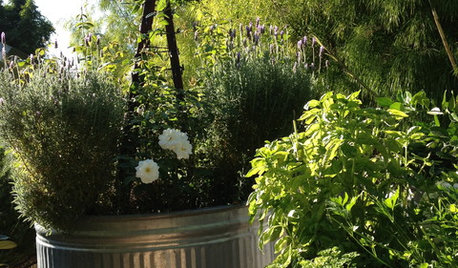Can cuttings grow THAT fast?
mark4321_gw
15 years ago
Related Stories

FALL GARDENING5 Fall Fruits You Can Grow in Containers
Brighten your porch or patio with a potted pomegranate, kumquat, blueberry bush or another great fall fruit
Full Story
SPRING GARDENINGHow to Grow a Rose Garden in Pots
Everything can come up roses, even without a plot of soil in sight. This step-by-step guide to growing roses in containers shows you how
Full Story
EDIBLE GARDENSGrow Herbs for Fresh Flavor and Good Looks in the Garden
With sun and a patch of ground, you can have all the fresh flavor you need for cooking right outside your door. Here's how to get started
Full Story
GARDENING GUIDESHerb Garden Essentials: Grow Your Own Delicious Mint
Pull out a pot for this one. Mint's spreading habit and hard-to-kill nature can be a blessing — if you're properly prepared
Full Story
EDIBLE GARDENSHow to Grow Your Own European and Asian Pears
Try these trees for their good looks, delicious fruit and wide range of sizes — plus you can espalier them
Full Story
THE ART OF ARCHITECTURELaser-Cut Focus: The Future of Design Is Here
Discover how this laser technology can make almost any pattern a reality
Full Story
GARDENING GUIDES9 Low-Growing Hedges That Make Good Neighbors
Define garden areas or borders without blocking the view, with these evergreen shrubs that take kindly to trimming
Full Story
EDIBLE GARDENSWhy Grow Quince? For Beauty, Fragrance and Old-Time Flavor
Delightfully perfumed fruit and lovely spring blossoms make this apple and pear cousin worth a spot in the garden
Full Story
HOUZZ TOURSHouzz Tour: A Compact Bungalow Makes Room for Growing Kids
When their 1927 Spanish bungalow began to shrink as their kids grew, the Roskins added square footage and more entertainment space
Full Story
COOL-SEASON CROPSCool-Season Vegetables: How to Grow Potatoes
This ever-popular tuber is a stalwart in spring and fall gardens and a staple in kitchens everywhere
Full StorySponsored






jblaschke
mark4321_gwOriginal Author
Related Professionals
Foothill Ranch Landscape Architects & Landscape Designers · Piqua Landscape Architects & Landscape Designers · Vernon Hills Landscape Architects & Landscape Designers · Brooklyn Center Landscape Architects & Landscape Designers · Boca Raton Landscape Contractors · Framingham Landscape Contractors · Hollywood Landscape Contractors · Salem Landscape Contractors · Raynham Driveway Installation & Maintenance · De Luz General Contractors · Linton Hall General Contractors · Modesto General Contractors · Montebello General Contractors · Rock Island General Contractors · Union Hill-Novelty Hill General Contractorsjblaschke
passionflow
mark4321_gwOriginal Author
jblaschke
passionflow
jblaschke
passionflow
mark4321_gwOriginal Author
mark4321_gwOriginal Author
mark4321_gwOriginal Author
MissSherry
mark4321_gwOriginal Author